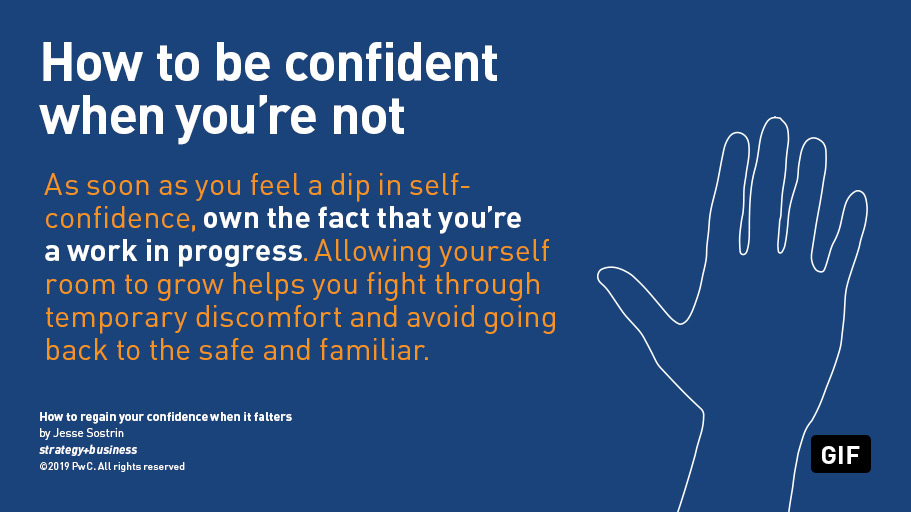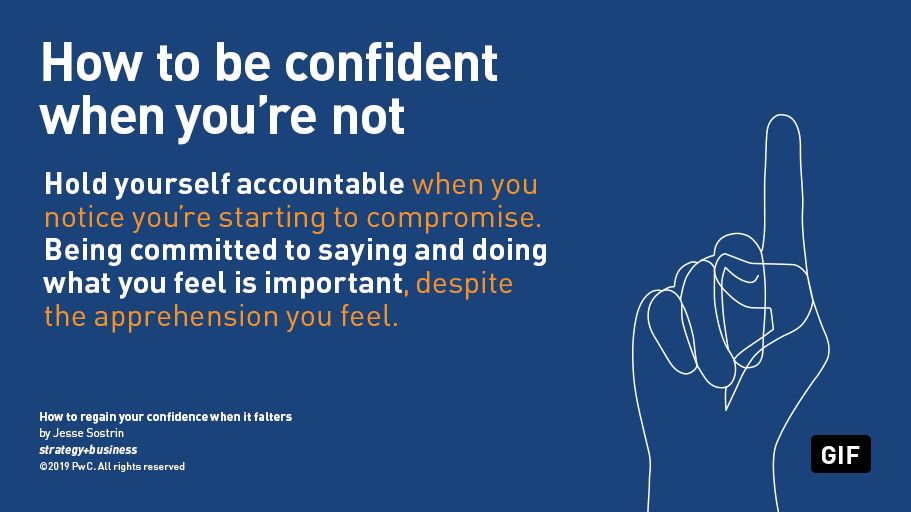How to regain your confidence when it falters
Two reflective strategies can help you manage dips in self-assurance and be a more effective leader. See also “How to be confident when you’re not.”
Confidence is a moving target. There are times when you, as a leader, feel strong and ready to confront your challenges head on. But in other moments you feel totally overmatched by circumstances and ill-equipped to respond. This is human nature, and every leader — regardless of tenure and talent — experiences a relentless pendulum swing of self-assurance.
I call this drop from high confidence to low “the dip.” Leaders at every level experience their own version of the dip, and its unsettling motion can cause even the most talented ones to disappear in the moments that matter. When the dip lingers, it can trigger a long-lasting funk with secondary consequences.
So which leader are you today? Are you the person at the pinnacle of confidence, fearlessly charging the next hill, or the timid individual dwelling in the dip and feeling more like a fraud than like someone to follow?


No matter where you are on the confidence scale, the good news is that your impact isn’t influenced by the fact that your confidence level wavers; it’s measured by how effectively you swing it back to the high end. Here are two strategies to help you manage the dip and be more confident in the moments when you’re not feeling self-assured.
1. Leverage the value of the dip
There’s a myth that leaders aren’t supposed to experience the dip — that others can, and will, but it’s a leader’s mandate never to slump. As psychologist and author David Kantor describes it: “When belief and faith plunge, leaders are on deck as their organization’s prime mover, its voice.… They know where to stand firm, casting an image of confidence others will follow.”
Your impact isn’t influenced by the fact that your confidence level wavers; it’s measured by how effectively you swing it back to the high end.
Kantor’s statement could be interpreted to mean that, by definition, you’re no longer leading when your confidence falters. However, another interpretation is possible, and by reframing the dip you can simultaneously ease your way out of it.
What if the dip is evidence that you’re poised for growth, ready to inch your way toward it?
Imagine you’re walking into an important meeting with high-level leaders. You aspire to communicate well, establish trust by sharing valuable and compelling insights, and ultimately earn the right to return. But if you’re new at it, the gap between your inexperience and your aspirations makes you highly susceptible to the dip.
As London Business School professor Herminia Ibarra says, intersectional moments like this can create an authenticity paradox, which is brought about when you cling to old, comfortable ways of being, at the expense of growing. The paradox occurs when you claim that by defaulting to the familiar you’re being “authentic,” even if it’s really just an excuse to stay in your comfort zone.
The solution is to courageously relabel yourself. For example, own the fact that you’re a work in progress. Doing so gives you permission to fight through the temporary discomfort of the dip and avoid retreating to the safe and familiar. It seems subtle, but this change in perspective can empower you to seize upon the character-building, trial-and-error efforts that are unavoidable when you’re stretching from the boundary of your past experience toward the new experience you aspire to.
Going back to the meeting example, the relabeling should start the minute you feel the dip coming on. Instead of clinging to an unrealistic interpretation of confidence (i.e., “When I step into that room, I firmly believe I’ll achieve the positive result I want, no matter what!”), follow your intuition and let that kind of false optimism give way to a more truthful but equally powerful stance: “The fact is, I’m new at this. So, when I step into that room, I expect to bump into the edge of my comfort zone — and when that happens, I’m committed to saying and doing what I feel is important despite the apprehension I know I’ll feel.”
2. Limit your inner compromise
In the early stages of a dip, your bosses, clients, and colleagues can’t see it unfolding. But if you’re honest and aware, you know when the slide has begun. One telltale sign is that you begin to negotiate with yourself and make internal compromises that convert your resolute intentions to passive actions. Consider these common examples and notice how they limit your own constructive effect on people and problems:
By catching yourself making a self-limiting compromise, you can pause, hold yourself accountable, and then better align your actions with your convictions. This is how you can behave your way out of the dip, and using these resilience-building pivot points can shorten the duration and limit the depth of the confidence gap.
Confidence is the scaffolding on which you stand. Its height determines your outlook, as well as the goals you’re willing to reach for. But like any temporary platform, it can be dismantled or built up quickly. In addition to these two strategies, the best way to keep adding to your scaffolding is to learn how to expect the low moments not with pessimism, but with resilience and awareness that you can turn things around by sticking with your plan. Having this outlook won’t prevent the dip, but it will prepare you to climb out of it faster.





